Related A problem in Mathematica 8 with function declaration
Clear["Global`*"]
model = 4/Sqrt[3] - a1/(x + b1) - a2/(x + b2)^2 - a3/(x + b3)^4;
fit = {a1 -> 0.27, a2 -> 0.335, a3 -> -0.347, b1 -> 4.29, b2 -> 0.435,
b3 -> 0.712};
functionB1[x_] = model /. fit;
functionB2[x_] := model /. fit;
The evaluation difference between functionB1 and functionB2 can be revealed by Trace command in mma, as below:
functionB1[Sqrt[0.2]] // Trace
functionB2[Sqrt[0.2]] // Trace
I have no question about functionB1. what puzzles me is that because functionB2[Sqrt[0.2]] doesn't even gives a numeric result but gives a function of x 4/Sqrt[3] - 0.335/(0.435 + x)^2 + 0.347/(0.712 + x)^4 - 0.27/(
4.29 + x), and then how its plot Plot[functionB2[Sqrt[x]], {x, 0, 1}] is possible?
I mean when you run Plot[functionB2[Sqrt[x]], {x, 0, 1}], what happens inside mma is:
x takes a number, say, 0.2, then 0.2 is finally passed to functionB2, but functionB2 gives a function, not a number. Then how is the following figure generated?

And its trace result ( Plot[functionB2[Sqrt[x]], {x, 0, 1}] // Trace ) seems very unreadable. I wonder the clear plotting process of functionB2. Can anybody show it?
thanks~ :)
